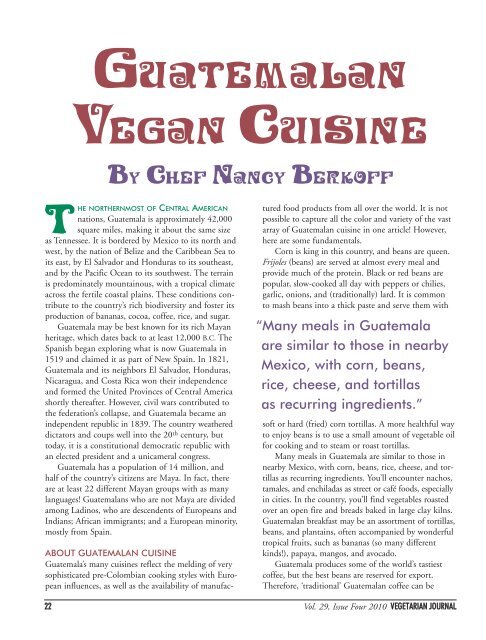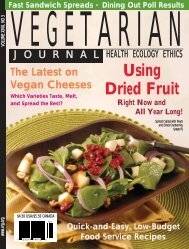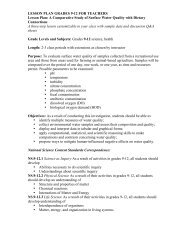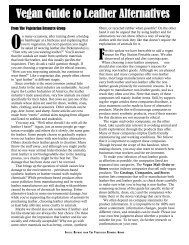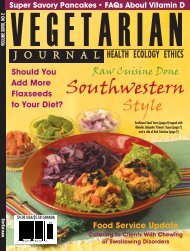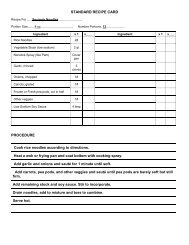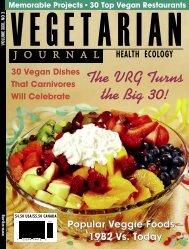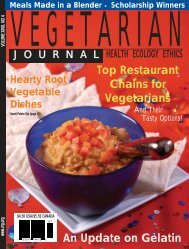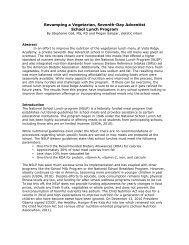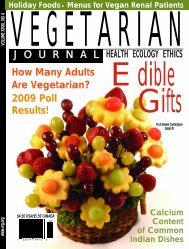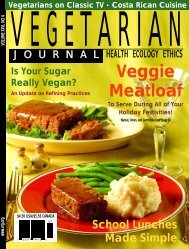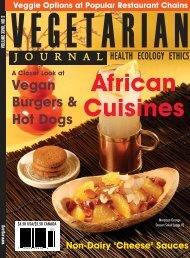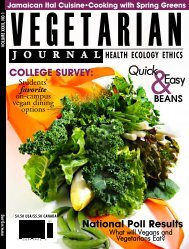GuatemalanVegan CuisineBy Chef Nancy BerkoffTHE NORTHERNMOST OF CENTRAL AMERICANnations, Guatemala is approximately 42,000square miles, making it about the same sizeas Tennessee. It is bordered by Mexico to its north andwest, by the nation of Belize and the Caribbean Sea toits east, by El Salvador and Honduras to its southeast,and by the Pacific Ocean to its southwest. <strong>The</strong> terrainis predominately mountainous, with a tropical climateacross the fertile coastal plains. <strong>The</strong>se conditions contributeto the country’s rich biodiversity and foster itsproduction of bananas, cocoa, coffee, rice, and sugar.Guatemala may be best known for its rich Mayanheritage, which dates back to at least 12,000 B.C. <strong>The</strong>Spanish began exploring what is now Guatemala in1519 and claimed it as part of New Spain. In 1821,Guatemala and its neighbors El Salvador, Honduras,Nicaragua, and Costa Rica won their independenceand formed the United Provinces of Central Americashortly thereafter. However, civil wars contributed tothe federation’s collapse, and Guatemala became anindependent republic in 1839. <strong>The</strong> country weathereddictators and coups well into the 20 th century, buttoday, it is a constitutional democratic republic withan elected president and a unicameral congress.Guatemala has a population of 14 million, andhalf of the country’s citizens are Maya. In fact, thereare at least 22 different Mayan groups with as manylanguages! Guatemalans who are not Maya are dividedamong Ladinos, who are descendents of Europeans andIndians; African immigrants; and a European minority,mostly from Spain.ABOUT GUATEMALAN CUISINEGuatemala’s many cuisines reflect the melding of verysophisticated pre-Colombian cooking styles with Europeaninfluences, as well as the availability of manufacturedfood products from all over the world. It is notpossible to capture all the color and variety of the vastarray of Guatemalan cuisine in one article! However,here are some fundamentals.Corn is king in this country, and beans are queen.Frijoles (beans) are served at almost every meal andprovide much of the protein. Black or red beans arepopular, slow-cooked all day with peppers or chilies,garlic, onions, and (traditionally) lard. It is commonto mash beans into a thick paste and serve them with“Many meals in Guatemalaare similar to those in nearbyMexico, with corn, beans,rice, cheese, and tortillasas recurring ingredients.”soft or hard (fried) corn tortillas. A more healthful wayto enjoy beans is to use a small amount of vegetable oilfor cooking and to steam or roast tortillas.Many meals in Guatemala are similar to those innearby Mexico, with corn, beans, rice, cheese, and tortillasas recurring ingredients. You’ll encounter nachos,tamales, and enchiladas as street or café foods, especiallyin cities. In the country, you’ll find vegetables roastedover an open fire and breads baked in large clay kilns.Guatemalan breakfast may be an assortment of tortillas,beans, and plantains, often accompanied by wonderfultropical fruits, such as bananas (so many differentkinds!), papaya, mangos, and avocado.Guatemala produces some of the world’s tastiestcoffee, but the best beans are reserved for export.<strong>The</strong>refore, ‘traditional’ Guatemalan coffee can be22 Vol. 29, <strong>Issue</strong> Four <strong>2010</strong> VEGETARIAN JOURNAL
weak, served with lots of sugar. Another popular drinkis atol, a hot beverage made from mashed corn, canesugar, cinnamon, vanilla, and optional chocolate or fruit.<strong>The</strong>re are many versions of atol (or atole) in Centraland South America, and ingredients and thicknessvary across countries and regions. Atol is common forbreakfast, but it is frequently served with tamales fordinner. It is particularly popular during the Christmasholiday season.VEGAN-FRIENDLY FARESome Guatemalan foods can easily ‘translate’ intomeat- and dairy-free cuisine: Kak’ik is a traditional Mayan soup made withturkey and seasoned with coriander, achiote orannatto (providing a brilliant orange-yellow color),and chilies. Smoked tofu or tempeh can easily beused to replace the turkey. Chile rellenos are chilies stuffed with rice, cheese,meat, and vegetables. <strong>The</strong>se do very well using veganground round or soy chorizo and vegan cheese. Tamalitos are similar to small, steamed tamales,and the corn masa filling can be made without meat.Tamalitos are sometimes flavored with chipilin, amild fresh mint, and served with sour cream. Pupusas come in many varieties but are generallysoft, thick corn tortillas filled with cheese or meat,folded and browned on a grill, and served with atomato-based sauce. Squash and refried beans arealso traditional fillings, so you can easily convertthis ‘fast food’ to vegan without sacrificing itsauthenticity or flavor. Elotes, or roasted ears of corn, are usually purchasedon the street and topped with lime, chili powder,cheese, butter, or mayonnaise. Use vegan shreddedcheese and a vegan mayonnaise, and you are inbusiness! If you can find green mangos in a local market,serve them as chefs in Guatemala would—sprinkledwith chili powder and lime. You are probably familiar with guacamole, ripeavocadoes mashed with lime or lemon juice andmixed with onions, tomatoes, cilantro, and possiblygarlic. Guacamole is served as a snack withchips or used to top entrées. <strong>The</strong> spicy pumpkin and sesame sauce that istraditionally served with Chicken Pepian is alreadyvegan! <strong>The</strong> pumpkin and sesame seeds are groundinto a paste and combined with water, cilantro, andtomatillos. This sauce can be served over grilledvegetables, grilled firm tofu or seitan, or rice. Licuados are thinner versions of milkshakes orsmoothies, made with fresh fruit and milk andserved at room temperature. Licuados do very wellwith vanilla soymilk, rice milk, or almond milk,combined with fresh or frozen mango, strawberry,guava, pineapple, or banana.And the list of tempting foods could go on and on!If your mouth was watering as you read about thedishes above, you may want to begin your Guatemalanculinary adventure with the ideas below.CUCUMBER SOUP(Serves 5)For this recipe, you’ll want ‘solid’ younger cucumbers.<strong>The</strong> fewer seeds, the better. If your cucumbers have greatnumbers of seeds, you may want to substitute 1 /2 cup (or1/4 pound) of diced fresh yellow squash for more texture.If pepino melons are available, they can be used in placeof the cucumbers.Vegetable oil spray3/4 cup chopped yellow onions1 pound (approximately 2 1 /2 cups) peeled, chopped cucumbers1/2 cup chopped red or yellow bell peppers3 cups low-sodium vegetable broth1/2 teaspoon ground black pepper4 Tablespoons vegan sour cream or plain soy yogurt1 Tablespoon chopped fresh cilantroHeat a large pot and spray with vegetable oil. Add theonions and cook, stirring, over medium heat until soft,approximately 2-4 minutes. Add cucumbers and bellpeppers, stirring and cooking until all of the vegetablesare soft, approximately 10 minutes. Add the broth andblack pepper, stir to combine, cover, and allow soupto simmer for 10 minutes.Remove from heat. In batches, purée soup in ablender or food processor. Return to pot, bring to asimmer, and allow soup to cook for 5 minutes. Pourinto individual bowls, top with vegan sour cream andcilantro, and serve immediately.Total calories per serving: 71Carbohydrates: 11 gramsSodium: 151 milligramsFat: 2 gramsProtein: 1 gramFiber: 1 gramVEGETARIAN JOURNAL Vol. 29, <strong>Issue</strong> Four <strong>2010</strong> 23


